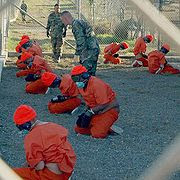By Karen Greenberg
The most amazing fact about the more than 700 previously unseen classified Guantánamo documents released by WikiLeaks and several unaffiliated news organizations the night of Sunday, April 24, is how little in them is new. The information in these documents — admittedly not classified “top secret” but merely “secret” — spells out details that buttress what we already knew, which is this: From day one at Guantánamo, the U.S. national security apparatus has known very little about the detainees in custody. The United States does not know who they are, how to assess what they say, and what threat they ultimately pose.
Given this vacuum of ignorance, U.S. officials decided at the outset that it was better to be safe than sorry. Therefore, any imaginable way in which behavior or statements could be deemed dangerous led to individual detainees being classified as “high risk.” The result was the policy we have seen since 2002 — a policy of assessing potential danger based on details like what kind of watches the detainees wore, the way they drew on the dirt floors of their cages, and whether they had travel documents on them. In addition, the just-released documents reaffirm the fact that much of the material on the detainees apparently came from hearsay derived from what seems to have been a limited number of interrogations, some performed under circumstances amounting to torture.
It is not just the conclusions of Guantánamo critics like myself that are being verified by these newly found documents. The conclusions of the judges who have sifted through available information to determine just who deserves to be at Guantánamo and who is being held on the basis of insufficient evidence have also been reinforced. In 58 habeas cases spanning both George W. Bush’s and Barack Obama’s administrations, federal judges have determined that in 36 of the cases there is insufficient evidence to hold these individuals and that often the detention was based on information obtained through hearsay, frequently the result of torture. In other words, the little evidence that existed was largely unreliable.
The sad fact is that these documents tell us more about ourselves than about the detainees. They tell us that U.S. officials to this day know very little based on hard evidence about the majority of those who have been held at Guantánamo, that assessments of risk have all too often been based on flights of imagination that tend to enhance the sense of power and capability of al Qaeda, and that the criteria for determining risk are at best murky. Those deemed to pose a risk ranged from individual detainees who proclaimed angry threats against their guards to those who were believed to have been actively involved in terrorism.
Former Defense Secretary Donald Rumsfeld once pointed out, in reference to the failure to find evidence of weapons of mass destruction in Iraq, that absence of evidence is not evidence of absence. Although the quip may seem facile, it is actually a candid assessment of what has gone wrong at Guantánamo from the time it opened in January 2002. It continues to go wrong to this day. The proper, lawful, most security-minded restatement of Rumsfeld’s maxim would be this: Absence of evidence requires better intelligence, more careful judgments, and more savvy realism. Without facts, it is not only the just treatment of detainees that is at issue — it is the security of the United States itself.
Karen Greenberg is executive director of the Center on Law and Security at the New York University School of Law and author of 0 Comments on Inside the vacuum of ignorance as of 1/1/1900




I can't imagine why anyone would want to be "the new Gitmo." Sounds like desperation to me. But then we have plenty of prisoners here in California...
Desperation. Definitely.
Or insanity.
Or misplaced patriotism.
Or collapsed synapses.
Or...
:-)
It's not about the physical facility which is Gitmo. That's really irrelevant. It's about refusing to designate men taken on the battlefield as prisoners of war, so that the edicts of the Geneva Convention do not apply, and it's about keeping people detained, without presenting charges, without granting a fair trial, etc.
That's what needs to end. There is no purpose served in closing one disastrous detainment camp.. to simply open another one somewhere else.
Every one of the men housed at Gitmo should have a fair trial. If we believe our justice system is the best in the world, the fairest and the most honorable.. well, let's show some real belief in that system.
..Let's show the world that we believe in our own system.
Gitmo is emblematic of how America turned away from its democratic ideals and tenets in response to terrorism threats. And it's also emblematic of Bush's lack of faith in democracy, which he was insisting we should promote around the world.
I agree, Lil. Obama is heading us in a new direction, the one we want to go in.
Oh yeah, as I put in my post:
"The US is not looking to recreate the Guantanamo experience somewhere else."
They should put the new Gitmo in Crawford, Texas.
WHY here? out of all you want saipan to be a TARGET for TERRORIST...? this is sooo DUMB... NICE TRY YUMUL!!!